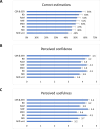Understanding effect size: an international online survey among psychiatrists, psychologists, physicians from other medical specialities, dentists and other health professionals
- PMID: 38388002
- PMCID: PMC10882338
- DOI: 10.1136/bmjment-2023-300978
Understanding effect size: an international online survey among psychiatrists, psychologists, physicians from other medical specialities, dentists and other health professionals
Abstract
Background and objective: Various ways exist to display the effectiveness of medical treatment options. This study examined various psychiatric, medical and allied professionals' understanding and perceived usefulness of eight effect size indices for presenting both dichotomous and continuous outcome data.
Methods: We surveyed 1316 participants from 13 countries using an online questionnaire. We presented hypothetical treatment effects of interventions versus placebo concerning chronic pain using eight different effect size measures. For each index, the participants had to judge the magnitude of the shown effect, to indicate how certain they felt about their own answer and how useful they found the given effect size index.
Findings: Overall, 762 (57.9%) participants fully completed the questionnaire. In terms of understanding, the best results emerged when both the control event rate (CER) and the experimental event rate (EER) were presented. The difference in minimal importance difference units (MID unit) was understood worst. Respondents also found CER and EER to be the most useful presentation approach while they rated MID unit as the least useful. Confidence in the risk ratio ranked high, even though it was rather poorly understood.
Conclusions and clinical implications: For dichotomous outcomes, presenting the effects in terms of the CER and EER could lead to the most correct interpretation. Relative measures including the risk ratio must be supplemented with absolute measures such as the CER and EER. Effects on continuous outcomes were better understood through standardised mean differences than mean differences. These can also be supplemented by dichotomised CER and EER.
Keywords: Data Interpretation, Statistical.
© Author(s) (or their employer(s)) 2024. Re-use permitted under CC BY-NC. Published by BMJ.
Conflict of interest statement
Competing interests: In the last 3 years, SL has received honoraria as a consultant and/or advisor and/or for lectures and/or for educational material from Alkermes, Angelini, Eisai, Gedeon Richter, Janssen, Lundbeck, Medichem, Medscape, Merck Sharpp and Dome, Mitshubishi, Neurotorium, NovoNordisk, Otsuka, Recordati, Roche, Rovi, Sanofi Aventis, TEVA. TAF reports personal fees from Boehringer-Ingelheim, DT Axis, Kyoto University Original, Shionogi and SONY and UpToDate, and a grant from Shionogi, outside the submitted work; In addition, TAF has patents 2020-548587 and 2022-082495 pending, and intellectual properties for Kokoro-app licensed to Mitsubishi-Tanabe.
Figures

Similar articles
-
Do clinicians understand the size of treatment effects? A randomized survey across 8 countries.CMAJ. 2016 Jan 5;188(1):25-32. doi: 10.1503/cmaj.150430. Epub 2015 Oct 26. CMAJ. 2016. PMID: 26504102 Free PMC article. Clinical Trial.
-
Placebos in clinical practice: comparing attitudes, beliefs, and patterns of use between academic psychiatrists and nonpsychiatrists.Can J Psychiatry. 2011 Apr;56(4):198-208. doi: 10.1177/070674371105600403. Can J Psychiatry. 2011. PMID: 21507276
-
Systematic reviews of the effectiveness of day care for people with severe mental disorders: (1) acute day hospital versus admission; (2) vocational rehabilitation; (3) day hospital versus outpatient care.Health Technol Assess. 2001;5(21):1-75. doi: 10.3310/hta5210. Health Technol Assess. 2001. PMID: 11532238 Review.
-
Beliefs about the helpfulness of interventions for mental disorders: a comparison of general practitioners, psychiatrists and clinical psychologists.Aust N Z J Psychiatry. 1997 Dec;31(6):844-51. doi: 10.3109/00048679709065510. Aust N Z J Psychiatry. 1997. PMID: 9483257
-
[Are schizophrenic patients being told their diagnosis today in France?].Encephale. 2017 Apr;43(2):160-169. doi: 10.1016/j.encep.2016.01.011. Epub 2016 Jun 29. Encephale. 2017. PMID: 27372353 Review. French.
Cited by
-
Initial treatment choices for long-term remission of chronic insomnia disorder in adults: a systematic review and network meta-analysis.Psychiatry Clin Neurosci. 2024 Nov;78(11):646-653. doi: 10.1111/pcn.13730. Epub 2024 Aug 26. Psychiatry Clin Neurosci. 2024. PMID: 39188094 Free PMC article.
-
Measuring loneliness: a head-to-head psychometric comparison of the 3- and 20-item UCLA Loneliness Scales.Psychol Med. 2024 Oct 31;54(14):1-7. doi: 10.1017/S0033291724002083. Online ahead of print. Psychol Med. 2024. PMID: 39479755 Free PMC article.
-
Nutrition Users' Guides: RCTs Part 2 - structured guide for interpreting and applying study results from randomised controlled trials on therapy or prevention questions.BMJ Nutr Prev Health. 2024 Aug 29;7(2):e000834. doi: 10.1136/bmjnph-2023-000834. eCollection 2024. BMJ Nutr Prev Health. 2024. PMID: 39882290 Free PMC article. Review.
References
-
- Higgins JPT, Li T, Deeks JJ. Chapter 6: choosing effect measures and computing estimates of effect. In: Higgins JPT, Thomas J, Chandler J, et al., eds. Cochrane handbook for systematic reviews of interventions version 6.3 (updated February 2022). Cochrane, 2022. Available: www.training.cochrane.org/handbook
MeSH terms
LinkOut - more resources
Full Text Sources
